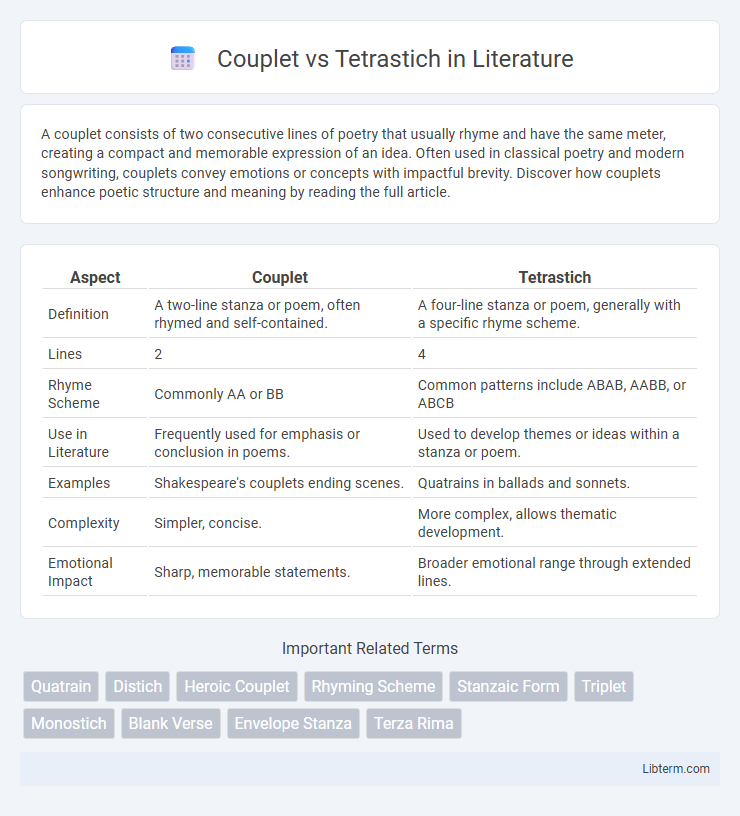A couplet consists of two consecutive lines of poetry that usually rhyme and have the same meter, creating a compact and memorable expression of an idea. Often used in classical poetry and modern songwriting, couplets convey emotions or concepts with impactful brevity. Discover how couplets enhance poetic structure and meaning by reading the full article.
Table of Comparison
| Aspect | Couplet | Tetrastich |
|---|---|---|
| Definition | A two-line stanza or poem, often rhymed and self-contained. | A four-line stanza or poem, generally with a specific rhyme scheme. |
| Lines | 2 | 4 |
| Rhyme Scheme | Commonly AA or BB | Common patterns include ABAB, AABB, or ABCB |
| Use in Literature | Frequently used for emphasis or conclusion in poems. | Used to develop themes or ideas within a stanza or poem. |
| Examples | Shakespeare's couplets ending scenes. | Quatrains in ballads and sonnets. |
| Complexity | Simpler, concise. | More complex, allows thematic development. |
| Emotional Impact | Sharp, memorable statements. | Broader emotional range through extended lines. |
Introduction to Couplet and Tetrastich
Couplet consists of two lines of verse that usually rhyme and share the same meter, creating a concise and impactful poetic expression. Tetrastich, on the other hand, comprises four lines of poetry, often with varied rhyme schemes like ABAB or AABB, allowing greater thematic development. Both forms serve distinct functions in poetry, with couplets emphasizing brevity and tetrastichs providing a balanced structure for extended ideas.
Defining Couplet: Structure and Types
A couplet consists of two consecutive lines of poetry that typically rhyme and share the same meter, creating a concise and rhythmic unit. There are various types of couplets, including heroic couplets, which are written in iambic pentameter, and rhymed couplets, emphasizing end rhyme patterns. This structure contrasts with tetrastichs, which contain four lines and offer more complexity in rhyme schemes and thematic development.
Understanding Tetrastich: Form and Variations
A tetrastich is a poem or stanza consisting of four lines, each contributing to a unified theme or narrative, often employing rhyme schemes such as ABAB, AABB, or ABCB to enhance rhythm and musicality. Unlike a couplet, which contains only two lines usually with a rhyme pattern AA, tetrastichs allow for greater complexity and variation in meter and rhyme, offering poets flexibility in expression. Variations of tetrastich include quatrains and certain forms of limericks and ballads, making it a versatile structure in diverse poetic traditions.
Historical Origins of Couplet and Tetrastich
Couplets, consisting of two rhymed lines, trace their origins to ancient Chinese and classical Greek poetry, where they were often employed for epigrams and proverbs due to their concise and impactful form. Tetrastichs, four-line stanzas prominent in classical Arabic, Persian, and European medieval poetry, evolved to express more complex ideas and narratives within a compact structure. The historical development of couplets and tetrastichs reflects diverse literary traditions adapting these forms for thematic emphasis and rhythmic versatility.
Couplet vs Tetrastich: Key Structural Differences
A couplet consists of two consecutive lines of verse that usually rhyme and share the same meter, forming a concise, rhythmic unit. In contrast, a tetrastich is a stanza of four lines, often with varying rhyme schemes such as ABAB or AABB, allowing for more complex thematic development. The key structural difference lies in the number of lines and the flexibility of rhyme patterns, with couplets emphasizing brevity and tetrastichs offering expanded lyrical expression.
Thematic Usage in Poetry: Couplet and Tetrastich
Couplets often emphasize a single, impactful idea or theme, making them ideal for sharp conclusions and witty observations in poetry. Tetrastichs allow for more development and variation within a theme, offering poets the flexibility to explore emotions, imagery, or narrative progression across four lines. Thematic usage in couplets prioritizes brevity and punch, whereas tetrastichs provide a concise but richer thematic exploration.
Famous Examples of Couplets
Couplets, consisting of two rhymed lines often with the same meter, are famously exemplified in Alexander Pope's "An Essay on Criticism" with the line, "To err is human; to forgive, divine." Shakespeare's sonnets frequently employ couplets to conclude their quatrains, delivering impactful, memorable summaries. In contrast, tetrastichs feature four-line stanzas and are prominent in classical ballads and quatrain-based poetry, providing a broader narrative space than the concise couplet.
Notable Tetrastich Poems in Literature
Tetrastich poems, consisting of four-line stanzas, are prominent in classical and modern literature for their balanced rhythm and expressive depth. Notable examples include T.S. Eliot's "Four Quartets," where each section employs tetrastichs to convey complex themes of time and spirituality. The concise structure of tetrastichs allows poets to explore vivid imagery and concise philosophical insights, distinguishing them from the shorter couplet form.
When to Choose Couplet or Tetrastich in Writing
Couplets are ideal for emphasizing a single idea or creating a memorable, rhythmic punch, often used in poetry and aphorisms to deliver concise messages. Tetrastichs, consisting of four lines, allow for more complex development of a theme or narrative progression, providing greater depth and variation in rhyme or meter. Choose couplets when brevity and impact are crucial, and tetrastichs when you need to explore ideas with more elaboration or subtlety.
Conclusion: Couplet and Tetrastich in Modern Poetry
Couplet and tetrastich remain essential structural forms in modern poetry, offering distinct rhythmic and thematic possibilities. Couplets often deliver concise, impactful statements or conclusions, while tetrastichs provide a broader narrative scope and balanced symmetry. Contemporary poets leverage these forms to enhance emotional resonance and stylistic clarity in diverse poetic expressions.
Couplet Infographic

 libterm.com
libterm.com